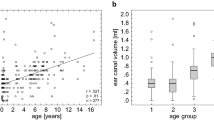Abstract
The aim of our study was to obtain wideband tympanometry (WBT) findings in Meniere’s disease (MD). It also aimed to evaluate whether the data obtained have diagnostic significance. 21 patients who were followed-up for unilateral Meniere’s Disease were evaluated. The ears with Meniere disease were grouped as the MD group and the opposite ears were grouped as the control group. WBT results were recorded as resonance frequency (RF) and frequency-specific absorbance values at 10 different frequencies in the 0.25–8.0 kHz range. Statistical analysis was performed with t test and receiver-operating characteristic analysis. Considering the WBT results, RF was significantly lower in the MD group compared to the control group (p < 0.001). Frequency-specific absorbance values at 0.25, 0.5, 0.75 and 1 kHz were significantly lower in the MD group compared to the control group (p < 0.05). No significant difference was found at 1.5 kHz and above (p > 0.05). For the MD, the RF below 598 Hz was 85.7% sensitive and 76.2% specific, the absorbance at 0.25 kHz below 8% was 66.7% sensitive and 61.9% specific, the absorbance below 17% at 0.5 kHz was 71.4% sensitive and 62.1% specific, the absorbance below 36% at 0.75 kHz was 81% sensitive and 57.8% specific, and the absorbance below 46% at 1 kHz was 71.5% sensitive and 66.7% specific. When MD was compared with intact ears, it was observed that RF was lower, and absorbance decreased in low frequencies. These data is statistically significant, but the sensitivity level is not enough for diagnostic use. Therefore, it is considered as an complementary test for the diagnosis.


Similar content being viewed by others
References
Paparella MM (1985) The cause (multifactorial inheritance) and pathogenesis (endolymphatic mal absorption) of Meniere’s disease and its symptoms (mechanical and chemical). Acta Otolaryngol 99:445–451
Magnan J, Özgirgin ON, Trabalzini F et al (2018) European position statement on diagnosis, and treatment of Meniere’s disease. J Int Adv Otol 14(2):317–321
Selvakumar P, Balraj A, Kurien R, Krishnan T (2012) Clinical and audio vestibular profile of Meniere’s disease in a tertiary care Centrein India. Indian J Otolaryngol Head Neck Surg 64(4):351–355
Committee on Hearing and Equilibrium guidelines for the diagnosis and evaluation of therapy in Menière’s disease (1995) American Academy of Otolaryngology-Head and Neck Foundation Inc. Otolaryngol Head Neck Surg 113(3):181–185
Loureiro RM, Sumi DV, Lemos MD et al (2019) The role of magnetic resonance imaging in Ménière disease: the current state of endolymphatic hydrops evaluation. Einstein (Sao Paulo) 17(1):eMD4743
Sugasawa K, Iwasaki S, Fujimoto C et al (2013) Diagnostic usefulness of multifrequency tympanomatry for Ménière’s disease. Audiol Neurotol 18:152–160
Lin MY, Timmer FC, Oriel BS et al (2006) Vestibular evoked myogenic potentials (VEMP) can detect asymptomatic saccular hydrops. Laryngoscope 116:987–992
Timmer FC, Zhou G, Guinan JJ, Kujawa SG, Herrmann BS, Rauch SD (2006) Vestibular evoked myogenic potential (VEMP) in patients with Ménière’s disease with drop attacks. Laryngoscope 116(5):776–779
de Kleine E, Mateijsen DJ, Wit HP, Albers FW (2002) Evoked otoacoustic emissions in patients with Ménière’s disease. Otol Neurotol 23(4):510–516
Franco-Vidal V, Legarlantezec C, Blanchet H, Convert C, Torti F, Darrouzet V (2005) Multifrequency admittancemetry in Ménière’s disease: a preliminary study for a new diagnostic test. Otol Neurotol 26:723–727
Yasui T, Iwasaki S, Sugasawa K et al (2012) Admittance tympanometry with 2-kHz probe tones in patients with low-frequency hearing loss. Laryngoscope 122(10):2252–2255
Demir E, Afacan NN, Celiker M et al (2018) Can wideband tympanometry be used as a screening test for superior semicircular canal dehiscence? Clin Exp Otorhinolaryngol. https://doi.org/10.21053/ceo.2018.01137
Carhart R, Jerger JF (1959) Pregerred method for clinical determination of pure-tone thresholds. J Speech Hear Dis 24(4):330–345
Lingam RK, Connor SE, Casselman JW, Beale T (2018) MRI in otology: applications in cholesteatoma and Ménière’s disease. Clin Radiol 73(1):35–44
Guneri EA, Çakır A, Mutlu B (2016) Validity and reliability of the diagnostic tests for Ménière’s disease. Turk Arch Otorhinolaryngol 54:124–130
Imai T, Uno A, Kitahara T et al (2017) Evaluation of endolymphatic hydrops using 3-T MRI after intravenous gadolinium injection. Eur Arch Otorhinolaryngol 274:4103–4111
Nakashima T, Naganawa S, Sugiura M et al (2007) Visualization of endolymphatic hydrops in patients with Meniere’s disease. Laryngoscope 117(3):415–420
Ng M, Srireddy S, Horlbeck DM, Niparko JK (2001) Safety and patient experience with transtympanic electrocochleography. Laryngoscope 111:792–795
Polat Z, Bas B, Hayır D, Bulut E, Atas A (2015) Wideband tympanometry normative data for Turkish young adult population. J Int Adv Otol 11:157–162
Bilgen C, Kirkim G, Kirazli T (2009) Middle ear impedance measurements in large vestibular aqueduct syndrome. Auris Nasus Larynx 36:263–268
Author information
Authors and Affiliations
Corresponding author
Ethics declarations
Conflict of interest
The authors declare that they have no conflict of interest.
Additional information
Publisher's Note
Springer Nature remains neutral with regard to jurisdictional claims in published maps and institutional affiliations.
Rights and permissions
About this article
Cite this article
Demir, E., Celiker, M., Aydogan, E. et al. Wideband Tympanometry in Meniere’s Disease. Indian J Otolaryngol Head Neck Surg 72, 8–13 (2020). https://doi.org/10.1007/s12070-019-01709-8
Received:
Accepted:
Published:
Issue Date:
DOI: https://doi.org/10.1007/s12070-019-01709-8




